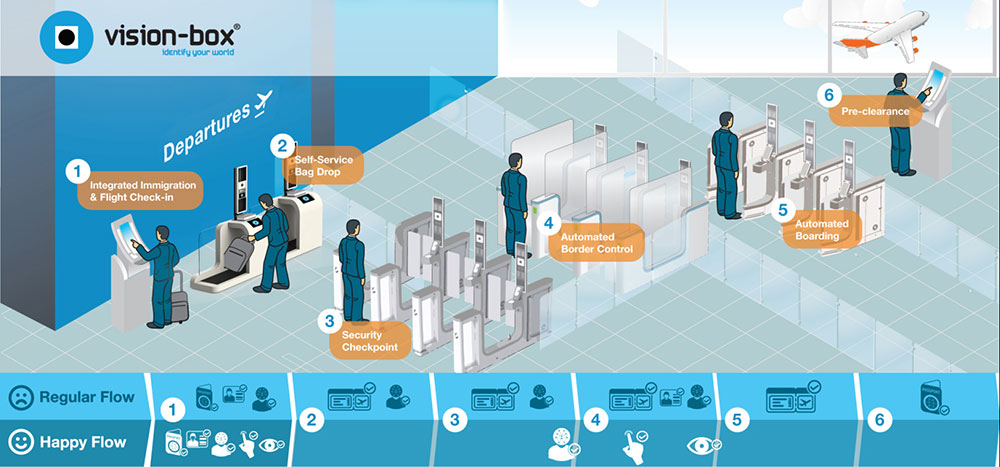As worldwide passenger numbers are constantly increasing, also competition in the industry of air travel and aviation does. To attract more and more savvy passengers towards the best service or deals, airports have to offer the simplest, fastest and personalized service experience ever.
This push airports to be more focused on their visitors, who are becoming more service-conscious and highly digitized shoppers. But to do this, a deeper knowledge of who are the passengers, what they want and what they need is required. And, mostly important in this context, how they move through and use the airports locations.
This leads to the requirement of measuring passenger flow. By doing it, airports could:
- Better allocate the staff and improve efficiency (having identified quickly the bottleneck)
- Reduce waiting time of passengers
- Make them happy
- Increase retail purchasing
There are different ways to measure passengers flow:
Using tracking device that works via Bluetooth, GSM and/or WiFi (but there are three main issues: lower capture rates, privacy concerns, and the fact that passengers have to switch on the device)
Using people counters, such as beam and thermal counters, synthetic intelligence, and video analytic (here we also have some issues: significantly dropped accuracy with the ordinary flows, systems often blocked or give the information only about number of people and not about time between different touch points).
Using Facial Recognition, which can capture really high number of anonymous facial images, track and measure the flow through touch points, such as check-in, security and passport control.
The last method makes also easier the setting of any threshold or alerts and improve efficiency in operation.
Ideally, in a fully biometric airport there will be no need for ID cards, tickets or even passports for passengers and workers as well, which would flow in a faster and more secure way through automated check points. This would enable a seamless and stress free journey for each single passenger through the airport.
We believe that this passenger could be happier and indeed more willing to spend and also to return again in this airport for its next experience.
The same picture of the future airport was delineated by Simone Menne, the CFO of Lufthansa, during her speech an ITB 2015 on the 4th March. She noticed that even if in the last ten years lot of changes occurred thanks to mobility and innovation, today the air travel process - from inspiration through sharing the experiences - still seems to be cumbersome: queuing, disruption, waiting and boring time.
She also agreed that new technologies could be helpful, and cited not only virtual and augmented reality or biometrics but also artificial intelligence and machine-to-machine technology, assuming that in the future airport service providers could talk together and through our devices could give us information about the whole process. And this is the point of concern.
As in the case of beacons, a great effort and focus is required by all the entities working with airports: handlers or control authorities, airlines, technology partners, business partners, and other airports as well.
Leonarda Miglietta and Nadya Levitskaya
This push airports to be more focused on their visitors, who are becoming more service-conscious and highly digitized shoppers. But to do this, a deeper knowledge of who are the passengers, what they want and what they need is required. And, mostly important in this context, how they move through and use the airports locations.
This leads to the requirement of measuring passenger flow. By doing it, airports could:
- Better allocate the staff and improve efficiency (having identified quickly the bottleneck)
- Reduce waiting time of passengers
- Make them happy
- Increase retail purchasing
 |
| Source http://www.blipsystems.com/wp-content/uploads/2014/06/Passenger-profile_new-e1417524195135.png |
There are different ways to measure passengers flow:
Using tracking device that works via Bluetooth, GSM and/or WiFi (but there are three main issues: lower capture rates, privacy concerns, and the fact that passengers have to switch on the device)
Using people counters, such as beam and thermal counters, synthetic intelligence, and video analytic (here we also have some issues: significantly dropped accuracy with the ordinary flows, systems often blocked or give the information only about number of people and not about time between different touch points).
Using Facial Recognition, which can capture really high number of anonymous facial images, track and measure the flow through touch points, such as check-in, security and passport control.
The last method makes also easier the setting of any threshold or alerts and improve efficiency in operation.
 |
| Source http://www.futuretravelexperience.com/wp-content/uploads/2014/05/nftw-aruba-airport.jpg |
We believe that this passenger could be happier and indeed more willing to spend and also to return again in this airport for its next experience.
The same picture of the future airport was delineated by Simone Menne, the CFO of Lufthansa, during her speech an ITB 2015 on the 4th March. She noticed that even if in the last ten years lot of changes occurred thanks to mobility and innovation, today the air travel process - from inspiration through sharing the experiences - still seems to be cumbersome: queuing, disruption, waiting and boring time.
She also agreed that new technologies could be helpful, and cited not only virtual and augmented reality or biometrics but also artificial intelligence and machine-to-machine technology, assuming that in the future airport service providers could talk together and through our devices could give us information about the whole process. And this is the point of concern.
As in the case of beacons, a great effort and focus is required by all the entities working with airports: handlers or control authorities, airlines, technology partners, business partners, and other airports as well.
Leonarda Miglietta and Nadya Levitskaya
No comments:
Post a Comment